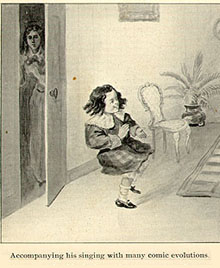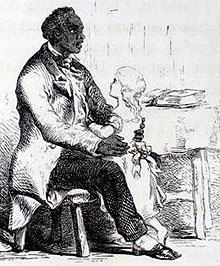Music is introduced into Uncle Tom's Cabin almost immediately. In the first chapter, readers are introduced to Eliza, the beautiful slave belonging to Mrs. Shelby, and Harry, Eliza's young son with her husband George Harris. In our first glimpse of Harry, he is forced by Mr. Shelby to perform, to dance and sing for the entertainment of Haley, the white slave trader:

"'Come here, Jim Crow,' said he. The child came up, and the master patted the curly head, and chucked him under the chin.
"'Now, Jim, show this gentleman how you can dance and sing.' The boy commenced one of those wild, grotesque songs common among the negroes, in a rich, clear voice, accompanying his singing with many comic evolutions of the hands, feet, and whole body, all in perfect time to the music." -- Chapter 1
Illustration from Art Memorial Edition
(Chicago: Monarch Book Company, 1897)
Hymns and religious songs make up most of the music of Uncle Tom's Cabin. In fact, Tom's hymnbook is as important to him as his Bible. Eva St. Clare, for example, often asks Uncle Tom to sing hymns to her. In chapter 16, she has the following exchange with her father, Augustine St. Clair:

"'But where has my little Eva been, all dinner-time?'
"'O, I've been up in Tom's room, hearing him sing, and Aunt Dinah gave me my dinner.'
"'Hearing Tom sing, hey?'
"'O, yes! he sings such beautiful things about the New Jerusalem, and bright angels, and the land of Canaan.'
"'I dare say; it's better than the opera, isn't it?'
"'Yes, and he's going to teach them to me.'"--Chapter 16
Illustration from Deluxe Illustrated
Edition (Boston: Jewett & Company, 1853)
Contemporary readers would have recognized hints of song and hymn titles and would have recognized allusions that readers today have difficulty tracing. The purpose of this exhibit is to help students learn about the music of Uncle Tom's Cabin. By using this site, students may:
